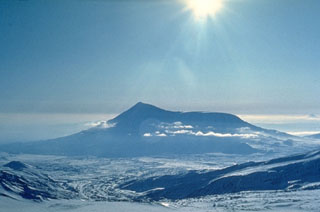Report on Tolbachik (Russia) — 28 November-4 December 2012
Smithsonian Institution / US Geological Survey
Weekly Volcanic Activity Report, 28 November-4 December 2012
Managing Editor: Sally Sennert.
Please cite this report as:
Global Volcanism Program, 2012. Report on Tolbachik (Russia) (Sennert, S, ed.). Weekly Volcanic Activity Report, 28 November-4 December 2012. Smithsonian Institution and US Geological Survey.
Tolbachik
Russia
55.832°N, 160.326°E; summit elev. 3611 m
All times are local (unless otherwise noted)
KVERT reported that an eruption from Tolbachik that began on 27 November continued through 30 November. Lava effused from two fissures along the W side of Tolbachinsky Dol, a lava plateau on the SW side of the volcano, and ash plumes rose less than 500 m on 28 November. A large thermal anomaly was detected on the N part of Tolbachinsky Dol. On 29 November the Aviation Color Code was raised to Red. Ash plumes rose less than 500 m and drifted 300 km ESE. Later that day seismicity decreased and the Aviation Color Code was lowered to Orange. During 29 November-1 December Strombolian activity and lava effusion from two fissures continued. A large thermal anomaly continued to be detected in satellite imagery, and ashfall was reported in Kozyrevsk (40 km NW). According to a news article on 30 November, the lava flows destroyed two scientific base camps 10 km away. On 1 December gas-and-steam plumes with small amounts of ash rose over 400 m.
Based on information from UHPP (Yelizovo Airport), the Tokyo VAAC reported that ash plumes rose to altitudes of 4-6.1 km (13,000-20,000 ft) a.s.l. and drifted N and NW during 29-30 November and 3 December.
Geological Summary. The massive Tolbachik volcano is located at the southern end of the Kliuchevskaya volcano group. The massif is composed of two overlapping, but morphologically distinct, volcanoes. The flat-topped Plosky Tolbachik shield volcano with its nested Holocene calderas up to 3 km in diameter is located east of the older and higher sharp-topped Ostry Tolbachik stratovolcano. The summit caldera at Plosky Tolbachik was formed in association with major lava effusion about 6,500 years ago and simultaneously with a major southward-directed sector collapse of Ostry Tolbachik. Long rift zones extending NE and SSW of the volcano have erupted voluminous basaltic lava flows during the Holocene, with activity during the past two thousand years being confined to the narrow axial zone of the rifts. The 1975-76 eruption originating from the SSW-flank fissure system and the summit was the largest historical basaltic eruption in Kamchatka.
Sources: Tokyo Volcanic Ash Advisory Center (VAAC), Kamchatkan Volcanic Eruption Response Team (KVERT)

